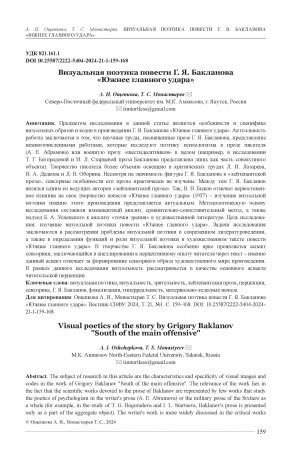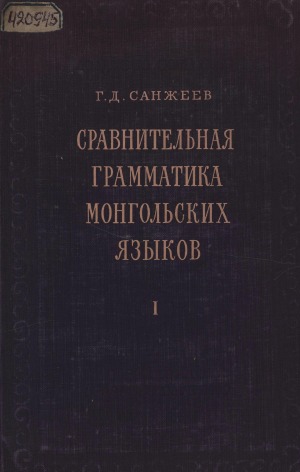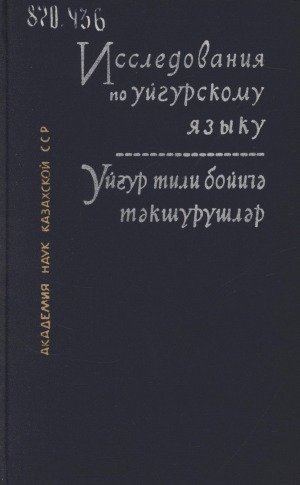- Книга (7159)
- Журнал (249)
- Автореферат диссертации (191)
- Аудиоиздание (756)
- Видеоиздание (676)
- Неопубликованный документ (17)
- Нотное издание (7)
- Фотография (4)
- Статья (991)
- Библиографический указатель (51)
- Словарь (215)
- Календарь (2)
- Брошюра (106)
- Буклет (1)
- Электронное издание (1)
- Грампластинка (19)
- Веб-архив (306)
- Азербайджанский (3)
- Бурятский (1)
- Чукотский (18)
- Долганский (10)
- Английский (66)
- Эскимоский (1)
- Эвенкийский (57)
- Эвенский (135)
- Французский (29)
- Немецкий (10)
- Хантыйский (1)
- Казахский (5)
- Корякский (3)
- Корейский (1)
- Мансийский (1)
- Нанайский (6)
- Ненецкий (3)
- Нивхский (6)
- Старорусский (6)
- Осетинский (1)
- Польский (1)
- Русский (5801)
- Латинская графика (221)
- Тунгусский (3)
- Турецкий (19)
- Тувинский (5)
- Якутский (4304)
- Юкагирский (35)
Количество страниц: 14 с.
- Языкознание. Филология. Художественная литература > Литература. Литературоведение > Теория литературы. Изучение литературы. Литературная техника > Художественная литература на отдельных языках > Якутская (саха) литература,
- НАУКА ЯКУТИИ > ЯЗЫКОЗНАНИЕ. ФИЛОЛОГИЯ. ЛИТЕРАТУРОВЕДЕНИЕ. ХУДОЖЕСТВЕННАЯ ЛИТЕРАТУРА > Литература. Литературоведение.
In his works, Dmitry Naumov created a special social and spiritual “microcosm” in the image of the Yakut village Charannaakh, since, in his opinion, the national identity of the Sakha people is formed precisely in rural areas. The writer's stories demonstrate a number of intra-genre varieties, starting with the main types of short prose – the actual story, short story, essay – and ending with synthetic and hybrid forms of short epic genres. Naumov's short stories feature satirical stories directed against bureaucrats, careerists, and lovers of the “green serpent”. Many of them contain everyday comedy, and in a number of the writer’s stories one can feel the features of the so-called “mischievous”tradition known in world literature, which often borders on “black” humor. Naumov’s humor is of a soft,“hinting” nature, and its meaning is hidden in allegories and subtext. A whole series of stories is dedicated to animals: the author’s bestiary includes horses, cows, dogs, cats, even piglets. The writer demonstrates extraordinary skill in creating crowd scenes and identifying the “collective consciousness.” At thesame time, his artistic anthropology contains many vivid individualized images. In many of Naumov’sstories one can feel his talent as a playwright. If the writer’s short stories demonstrate different types ofshort prose, then the genre designations of his dramatic works are limited to only two definitions – “play”in the sense of “drama” and “comedy”. The only dramatic work that is not accompanied by an author's genre definition is “Autumn.” Judging by the brief initial remark, adherence to the principleof “three unities,” the absence of external events, and the minimum of characters, this is a psychological monodrama. In his comedies, as in his stories, Naumov used a whole system of poetic means andtechniques, starting with such as literary allusions, poetics of names, animalistic imagery, and ending with the verbal self-disclosure of the characters. To enhance the ironic context, they mention the characters of S.S. Yakovlev-Erilik Eristin, poor Khachygyr, D. K. Sivtsev-Suorun Omollooa autocrat Makar, the “great strategist” Ostap Bender from the works of I. Ilf and E. Petrov, and adaptEllyai’s poems. Finally, Naumov himself is a brilliant expert on the native language, rightfully throws a stone at supporters of excessive “Yakutization” of the language of the Sakha people.
Бурцев, А. А. Проблематика и поэтика произведений Дмитрия Наумова / А. А. Бурцев, М. А. Бурцева ; Северо-Восточный федеральный университет им. М. К. Аммосова // Вестник Северо-Восточного федерального университета им. М. К. Аммосова. Серия: Вопросы национальных литератур. - 2024. - N 1 (13). - С. 5-18. - DOI: 10.25587/2782-6635-2024-1-5-18
DOI: 10.25587/2782-6635-2024-1-5-18
Количество страниц: 8 с.
- Языкознание. Филология. Художественная литература > Литература. Литературоведение > Теория литературы. Изучение литературы. Литературная техника > Художественная литература на отдельных языках,
- НАУКА ЯКУТИИ > ЯЗЫКОЗНАНИЕ. ФИЛОЛОГИЯ. ЛИТЕРАТУРОВЕДЕНИЕ. ХУДОЖЕСТВЕННАЯ ЛИТЕРАТУРА > Языкознание и языки. Лингвистика.
Teki Odulok's travel essay is the first work devoted to a journey through the northernmost regions of the Russian Federation undertaken by a compatriot, a representative of the smallest Russian people - the Yukaghir, in the 20s of the twentieth century. The article presents the results of the study of the content of the travelogue, its chronotopes, descriptions of nature at different geographical latitudes, culture and life of the unique endemic peoples inhabiting the territory: the Yukaghirs (Oduls), Russian-Ustintsy, Chukchi, Evens, Evenks (Lamuts). It is proven that the work is a narrative, objectively related to the history and geographical location of the region, political and cultural events in the Soviet Union at the beginning of the twentieth century. The novelty is justified by the fact that the essay has the characteristics of a travelogue in the modern sense, and therefore the readers, regardless of their nationality and place of residence, perceive it with interest. The influence of the professional view of a scientist-economist on the style of literary narration is shown, which provides an enriched description of travel along a specific route and an evidential connection with the modern economic state of the regions described. Complete discourses combining documentary narration, presentation of real facts about harsh conditions of survival and description of life and customs of representatives of small number of peoples - endemics - are highlighted. Methods of comparison and literary retroscopy were used, which allowed to confirm the author's assumptions about the development of the region in literary and documentary form. The article may be of interest not only to philologists and specialists in the field of national cultures, but also to interested readers.
Третьякова, Т. В. Путевой очерк Тэки Одулока "На Крайнем Севере" – первый травелог начала ХХ века / Т. В. Третьякова ; Северо-Восточный федеральный университет им. М. К. Аммосова // Вестник Северо-Восточного федерального университета им. М. К. Аммосова. - 2024. - Т. 21, N 1 (95). - С. 178-185. - DOI: 10.25587/2222-5404-2024-21-1-178-185
DOI: 10.25587/2222-5404-2024-21-1-178-185
Количество страниц: 9 с.
- Языкознание. Филология. Художественная литература > Литература. Литературоведение > Теория литературы. Изучение литературы. Литературная техника > Художественная литература на отдельных языках,
- НАУКА ЯКУТИИ > ЯЗЫКОЗНАНИЕ. ФИЛОЛОГИЯ. ЛИТЕРАТУРОВЕДЕНИЕ. ХУДОЖЕСТВЕННАЯ ЛИТЕРАТУРА > Языкознание и языки. Лингвистика.
The research is carried out in the context of interdisciplinary cognitive directions - cognitive linguistics and cognitive poetics, one of the actual tasks of which is modeling the structure of artistic concepts represented in the artistic text. The aim of the study is modeling of the artistic concept of cold in the author’s artistic picture of the world of Y. S. Rytkheu as a part of the conceptosphere of the Arctic discourse. This research is the first stage in the study of artistic concepts in the Arctic discourse of Y. S. Rytkheu. The novel of this Chukchi writer, who is a representative of the northern linguoculture, was analysed. The relevance of this study is determined by the choice of the concept of cold as one of the key discursive concepts of the North and the Arctic, as well as its inclusion in the paradigm of linguocognitive research and conceptology of the artistic text. The method of continuous sampling was used to extract 456 markers - representatives of the concept. The markers were distributed into lexico-thematic groups (hereinafter - LTG) “Nature” (211), “Human Impact” (142), “Dwelling” (44), “Technology” (39), “Equipment” (20), interpreted as cognitive attributes of the concept. The distribution into LTGs was made according to the signs of semantic and thematic commonality of the concept markers. The following structure of the artistic concept cold was revealed: in the nuclear zone there is the cognitive attribute “Nature” (211 markers), in the ancillary zone - “Human Impact” (142 markers), in the near periphery there is the attribute “Dwelling”, in the far periphery “Equipment” and “Technics”. Such cognitive features of the artistic concept of cold as the Arctic climate of Chukotka, natural phenomena associated with cold, the impact of cold on people and their activities are defined.
Павлов, С. С. Художественный концепт холод в произведении чукотского писателя Ю. Рытхэу "Айвангу" / С. С. Павлов, О. А. Мельничук ; Северо-Восточный федеральный университет им. М. К. Аммосова // Вестник Северо-Восточного федерального университета им. М. К. Аммосова. - 2024. - Т. 21, N 1 (95). - С. 169-177. - DOI: 10.25587/2222-5404-2024-21-1-169-177
DOI: 10.25587/2222-5404-2024-21-1-169-177
Количество страниц: 10 с.
- Языкознание. Филология. Художественная литература > Литература. Литературоведение > Теория литературы. Изучение литературы. Литературная техника > Художественная литература на отдельных языках,
- НАУКА ЯКУТИИ > ЯЗЫКОЗНАНИЕ. ФИЛОЛОГИЯ. ЛИТЕРАТУРОВЕДЕНИЕ. ХУДОЖЕСТВЕННАЯ ЛИТЕРАТУРА > Языкознание и языки. Лингвистика.
The subject of research in this article are the characteristics and specificity of visual images and codes in the work of Grigory Baklanov "South of the main offensive". The relevance of the work lies in the fact that the scientific works devoted to the prose of Baklanov are represented by few works that study the poetics of psychologism in the writer's prose (A. E. Abramova) or the military prose of the Sixtiers as a whole (for example, in the study of T. G. Bogoradova and I. L. Startseva, Baklanov's prose is presented only as a part of the aggregate object). The writer's work is more widely discussed in the critical works of L. I. Lazarev, I. A. Dedkov and L. V. Oborin. Despite the importance of the figure of Grigory Baklanov in the "lieutenant prose", the sensual features of his prose are practically not studied. Meanwhile, Grigory Baklanov was one of the leading authors of "lieutenant prose". Thus, V. V. Bykov noted the primary influence on his work of the story "South of the main offensive" (1957) - the study of the visual poetics of this very work seems relevant. The methodological basis of the research was the immanent analysis, the comparative-comparative method, as well as B. A. Uspensky's approach to the analysis of the "point of view" in fiction. Aim of the research is to study the visual poetics of the story "South of the main offensive". The aim of the study is to consider the problem of visual poetics in modern literary studies, as well as to determine the functions and role of visual poetics in the artistic text of the story "South of the main offensive". In the work of Grigory Baklanov, the aspect of sensory poetics, which consists in appealing to the reader's perceptual experience through the text, is particularly pronounced - it is this aspect that is responsible for the formation of the sensory image of the artistic world of the work. In this study, visuality is considered as the main aspect of the reader's perception.
Ощепкова, А. И. Визуальная поэтика повести Г. Я. Бакланова "Южнее главного удара" / А. И. Ощепкова, Т. С. Монастырев ; Северо-Восточный федеральный университет им. М. К. Аммосова // Вестник Северо-Восточного федерального университета им. М. К. Аммосова. - 2024. - Т. 21, N 1 (95). - С. 159-168. - DOI: 10.25587/2222-5404-2024-21-1-159-168
DOI: 10.25587/2222-5404-2024-21-1-159-168
Количество страниц: 12 с.
- Языкознание. Филология. Художественная литература > Литература. Литературоведение > Теория литературы. Изучение литературы. Литературная техника > Художественная литература на отдельных языках > Якутская (саха) литература,
- НАУКА ЯКУТИИ > ЯЗЫКОЗНАНИЕ. ФИЛОЛОГИЯ. ЛИТЕРАТУРОВЕДЕНИЕ. ХУДОЖЕСТВЕННАЯ ЛИТЕРАТУРА > Языкознание и языки. Лингвистика.
In recent years, an active appeal to the discourse of cold as a scientific problem has been observed in science, which is partly due to some extent to the transformation of the worldview of modern man, partly to the awareness of the fragility of the world balance in a globalising space. At the same time, the lack of development of the methodology, which consists in the absence of a conceptual, informational base, separate tools, creates difficulties in implementation this problem. In this regard, the topic presented in this article undoubtedly has great scientific potential and novelty in the context of the problem of geo-culture of the North. The purpose of the study is to study the concept of cold in the context of the geo-cultural landscape of Yakutia as a semantic structure, which manifests itself in the constancy of images, universals with cultural, historical, mental community and united in a single artistic system. The author pays special attention to the reception of the concept of cold in the aspect of binary positions of one's own and another's, where one's own is represented by an associative series of native, close, bright, safe, and participates in the formation of unique characteristics of the national world. The main attention is paid to the initial properties of cold, which form the borders of the Yakut world and participating in the design of a specific mental picture of Sakha, which is quite clearly reflected in the images of the initiating heroes of P.A. Oyunsky. In addition, the subject of the study is also the specifics of cold and its role in the actualisation of the unique geo-cultural quality of the city of Yakutsk as the coldest, most distant city, “the city on the edge”. The methods used in the article were systemic, structural research methods. Results. The study of this concept in the literary aspect helps to identify the peculiarities of the individual style, the author's position, and the peculiarities of constructing a national picture of the world.
Ноева, С. Е. Поэтика холода в якутской прозе начала ХХ века: холод как граница якутского мира / С. Е. Ноева (Карманова) ; Институт гуманитарных исследований и проблем малочисленных народов Севера // Вестник Северо-Восточного федерального университета им. М. К. Аммосова. - 2024. - Т. 21, N 1 (95). - С. 147-158. - DOI: 10.25587/2222-5404-2024-21-1-147-158
DOI: 10.25587/2222-5404-2024-21-1-147-158
Количество страниц: 18 с.
From the card index “Phraseologisms characterising a human being in Yakut and Turkic languages of South Siberia, Turkish and Kazakh” compiled by the author, 75 lexeme-mongolisms in the Yakut language were identified. This article is the first special study of these lexemes-mongolisms, which are part of Yakut phraseologisms (somatisms; lexemes denoting objects of material culture). The aim of this study is to identify the area of distribution of Mongolisms included in Yakut phraseological phrases, to establish phraseological parallels in other Turkic languages, to determine the motivational bases of phraseological phrases characterising human beings. Thus, to make a certain contribution to the clarification of the problem of Yakut-Mongolian contacts. The value of phraseologisms lies in the fact that remaining unchanged, they preserve national identity and reflect the characteristic features of the historical epoch in which they originated. The study of Mongolisms in the Yakut language is based on the scientific works of E.I. Ubryatova, S. Kaluzhinsky, V.I. Rassadin, N.N. Shirobokova, N.K. Antonov, G.G. Levin, A.E. Shamaeva and others. As a result of the study, it was established that: Mongolisms included in Yakut phraseologisms can be subdivided into the following types - a) Mongolisms borrowed by the Turkic-speaking ancestors of the Yakuts back in the times when they lived in the “southern” ancestral homeland; b) Mongolisms previously acquired in the “southern” ancestral homeland as part of the Turkic Kypchak component; c) Mongolisms that penetrated already in geographically separated groups of Turkic languages from certain Mongolian languages; d) Mongolisms acquired through an “unknown” Middle Mongolian source language and/or Buryat language. The overwhelming majority of the considered Yakut phraseologisms with Mongolian components do not find parallels in the Turkic languages, which confirms the thesis that the formation of these phraseologisms took place in the process of their development under conditions of non-contact with the Turkic languages of South Siberia. The prospects of the study are seen in further reconstruction of the phraseological fund of the Yakut language in order to make a significant contribution to the solution of the problem of Yakut-Mongolian contacts.
Анисимов, Р. Н. Монгольские компоненты в составе якутских фразеологизмов, характеризующих человека (сравнительно-сопоставительный аспект) / Р. Н. Анисимов ; Северо-Восточный федеральный университет им. М. К. Аммосова // Вестник Северо-Восточного федерального университета им. М. К. Аммосова. - 2024. - Т. 21, N 1 (95). - С. 98-115. - DOI: 10.25587/2222-5404-2024-21-1-98-115
DOI: 10.25587/2222-5404-2024-21-1-98-115
Издательство: Академии наук СССР
Год выпуска: 1953
Серия, номер выпуска: Т. 1
Количество страниц: 250 с.
Издательство: Наука
Год выпуска: 1966
Серия, номер выпуска: Т. 1
Количество страниц: 720 с.
Издательство: Наука
Год выпуска: 1970
Серия, номер выпуска: Ч. 2
Количество страниц: 182 с.









